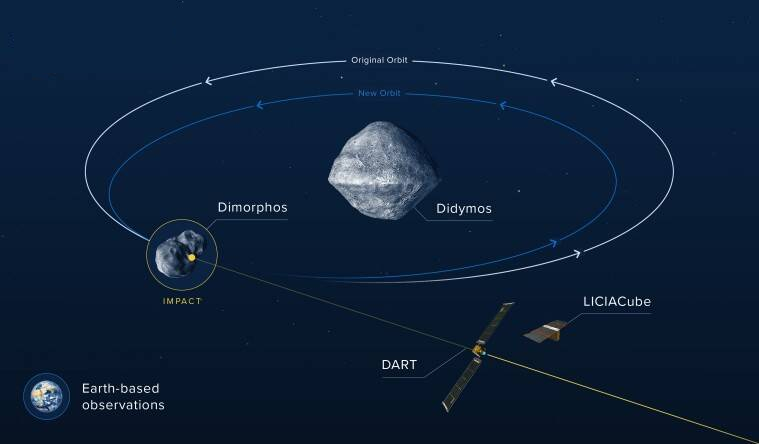Science & Technology
Double Asteroid Redirection Test (DART) Mission: NASA
- 12 Nov 2021
- 3 min read
Why in News
NASA will launch its first planetary defense test mission named the Double Asteroid Redirection Test (DART).
- The DART spacecraft will be launched on a SpaceX Falcon 9 rocket.
Key Points
- Aim of the Mission:
- The mission is to test the new technology to be prepared in case an asteroid heads towards Earth in the future.
- The aim is to test the newly developed technology that would allow a spacecraft to crash into an asteroid and change its course.
- After the mission has collided with the asteroid, scientists will study its impact on the trajectory of the asteroid with a range of telescopes deployed on different regions of the planet.
- DART will be the first demonstration of the kinetic impactor technique to change the motion of an asteroid in space.
- The target of the spacecraft is a small moonlet called Dimorphos (Greek for “two forms”).
- Dimorphos orbits a larger asteroid named Didymos (Greek for “twin”).
- It is a suicide mission and the spacecraft will be completely destroyed.
- The collision is expected to take place between 26th September and 1st October, 2022.
- About the Mission:
- DART is a low-cost spacecraft.
- It has two solar arrays and uses hydrazine propellant for maneuvering the spacecraft.
- It also carries about 10 kg of xenon which will be used to demonstrate the agency’s new thrusters called NASA Evolutionary Xenon Thruster–Commercial (NEXT-C) in space.
- NEXT-C gridded ion thruster system provides a combination of performance and spacecraft integration capabilities that make it uniquely suited for deep space robotic missions.
- The spacecraft carries a high-resolution imager called Didymos Reconnaissance and Asteroid Camera for Optical Navigation (DRACO).
- Images from DRACO will be sent to Earth in real-time and will help study the impact site and surface of Dimorphos (the target asteroid).
- DART will also carry a small satellite or CubeSat named LICIACube (Light Italian CubeSat for Imaging of Asteroids).
- LICIACube is expected to capture images of the impact and the impact crater formed as a result of the collision.
- Reason for Choosing Dimorphos:
- Didymos is a perfect system for the test mission because it is an eclipsing binary which means it has a moonlet that regularly orbits the asteroid and which can be seen when it passes in front of the main asteroid.
- Earth-based telescopes can study this variation in brightness to understand how long it takes Dimorphos to orbit Didymos.







